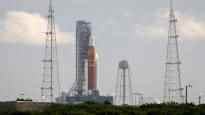The last manned spaceflight took place 50 years ago.
Jussi Nurminen,
Yrjö Kokkonen
29.8. 11:23•Updated 29.8. 15:55
The US space agency NASA has had to cancel its intention to launch a rocket into space, the capsule inside of which will orbit the Moon.
There was a two-hour time window for the launch of the rocket, which started at 15:33 Finnish time. However, Nasa discovered problems at the last minute that prevented the launch. The new possible launch time is Friday.
The problems concern, among other things, the temperature of one engine.
The goal is also a flight to Mars
The Space Launch System (SLS) rocket and the Orion capsule are part of NASA’s long-term project to send humans first to the surface of the Moon and later to the planet Mars.
The capsule that will possibly set off this week is unmanned, but with a similar device, astronauts would one day fly to the Moon’s chamber. So it’s a training flight.
It is planned to fly to Mars with these views in the 2030s.
At the time of departure, Nasa wanted to remember the famous Apollo program. This year marks 50 years since the Apollo 17 pilots set foot on the moon.
Huge thrust in the rocket
The SLS rocket uses liquid hydrogen and oxygen as fuel, 2.7 million liters of which have been pumped into the tanks before setting off.
The thrust of the rocket is a whopping 39 meganewtons. This is 15 percent more than the Saturn V rocket and one-fifth more than the rockets used for space shuttle launches.
The thrust of the SLS can also be compared to passenger plane engines. The SLS produces almost 60 times the power that the supersonic passenger plane Concorde’s engines produced when the plane took off.
Exceptional requirements for durability
The Artemis I flight will take the capsule around the Moon, after which it will take advantage of the Moon’s gravitational pull and head back to Earth.
When returning to Earth, the speed of the Orion capsule is up to 40,000 kilometers per hour, so the atmosphere causes enormous friction. For this reason, the capsule is protected by an exceptionally large, five-meter-diameter heat shield.
The temperature of the shield is estimated to rise to 2,760 degrees.
With the help of parachutes, the speed of the capsule slows down, so it falls into the sea at a speed of about 30 kilometers per hour.
The launch of a space rocket from the Kennedy Space Center in Florida will be a big media event. It is estimated that hundreds of thousands of people will arrive on the sandy beaches near the center to watch the start.
NASA has not yet selected the final crew for the manned flights. 13 candidates have been selected.
You can discuss the topic on 30.8. until 11 p.m.
